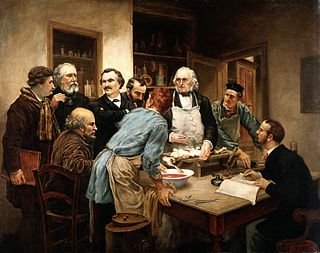
Physiology is the scientific study of functions and mechanisms in a living system. As a subdiscipline of biology, physiology focuses on how organisms, organ systems, individual organs, cells, and biomolecules carry out chemical and physical functions in a living system. According to the classes of organisms, the field can be divided into medical physiology, animal physiology, plant physiology, cell physiology, and comparative physiology.

Sir Edward Albert Sharpey-Schafer FRS FRSE FRCP was a British physiologist.
The Panofsky Prize in Experimental Particle Physics is an annual prize of the American Physical Society. It is given to recognize and encourage outstanding achievements in experimental particle physics, and is open to scientists of any nation. It was established in 1985 by friends of Wolfgang K. H. Panofsky and by the Division of Particles and Fields of the American Physical Society. Panofsky was a physics professor at Stanford University and the first director of the Stanford Linear Accelerator Center (SLAC). Several of the prize winners have subsequently won the Nobel Prize in Physics. As of 2021, the prize included a $10,000 award.
The Louisa Gross Horwitz Prize for Biology or Biochemistry is an annual prize awarded by Columbia University to a researcher or group of researchers who have made an outstanding contribution in basic research in the fields of biology or biochemistry.
The Rutherford Memorial Medal is an award for research in the fields of physics and chemistry by the Royal Society of Canada. It was dedicated to the memory of Ernest Rutherford. It is awarded once for physics and once for chemistry each year, "for outstanding research", when there is a suitable candidate.

The Royal Photographic Society of Great Britain, commonly known as the Royal Photographic Society (RPS), is one of the world's oldest photographic societies. It was founded in London, England, in 1853 as the Photographic Society of London with the objective of promoting the art and science of photography, and in 1853 received royal patronage from Queen Victoria and Prince Albert.
The E.B. Wilson Medal is the American Society for Cell Biology's highest honor for science and is presented at the Annual Meeting of the Society for significant and far-reaching contributions to cell biology over the course of a career. It is named after Edmund Beecher Wilson.
The Davisson–Germer Prize in Atomic or Surface Physics is an annual prize that has been awarded by the American Physical Society since 1965. The recipient is chosen for "outstanding work in atomic physics or surface physics". The prize is named after Clinton Davisson and Lester Germer, who first measured electron diffraction, and as of 2007 it is valued at $5,000.
The Earle K. Plyler Prize for Molecular Spectroscopy and Dynamics is a prize that has been awarded annually by the American Physical Society since 1977. The recipient is chosen for "notable contributions to the field of molecular spectroscopy and dynamics". The prize is named after Earle K. Plyler, who was a leading experimenter in the field of infrared spectroscopy; as of 2007 it is valued at $10,000. The prize is currently sponsored by the AIP Journal of Chemical Physics.
The Fluid Dynamics Prize is a prize that has been awarded annually by the American Physical Society (APS) since 1979. The recipient is chosen for "outstanding achievement in fluid dynamics research". The prize is currently valued at US$10,000. In 2004, the Otto Laporte Award—another APS award on fluid dynamics—was merged into the Fluid Dynamics Prize.
The Bicentenary Medal is a scientific award given by the Linnean Society. It is awarded annually in recognition of work done by a biologist under the age of 40 years. The medal was first awarded in 1978 on the 200th anniversary of the death of Carl Linnaeus.
The ISCB Overton Prize is a computational biology prize awarded annually for outstanding accomplishment by a scientist in the early to mid stage of his or her career. Laureates have made significant contribution to the field of computational biology either through research, education, service, or a combination of the three.
The Genetics Society of American Medal is a medal awarded by the Genetics Society of America (GSA) for outstanding contributions to the field of genetics in the last 15 years.
The Australian Institute of Physics was established in 1963, when it replaced the Australian Branch of the British Institute of Physics based in London. The purpose of the institute is to promote the role of physics in research, education, industry and the community. The AIP publishes Australian Physics since 1963. Every two years, the Institute organises a national congress, the latest being held in December 2022 in Adelaide.
The Eli Lilly Award in Biological Chemistry was established in 1934. Consisting of a bronze medal and honorarium, its purpose is to stimulate fundamental research in biological chemistry by scientists not over thirty-eight years of age. The Award is administered by the Division of Biological Chemistry of the American Chemical Society.

Elizabeth Matilda Tansey is an Emerita Professor of the history of medicine and former neurochemist, best known for her role in the Wellcome Trust's witness seminars. She previously worked at Queen Mary University of London (QMUL).
The Joan Mott Prize Lecture is a prize lecture awarded annually by The Physiological Society in honour of Joan Mott.
The Physiology Society Annual Review Prize Lecture is an award conferred by The Physiological Society. First awarded in 1968, it is one of the premier awards of the society.
The Outstanding Contribution to Computer Science Education award is a prize granted by the Association for Computing Machinery (ACM) Special Interest Group (SIG) on Computer science education (SIGCSE). Outstanding contributions can include curriculum design, innovative teaching methods, authorship of textbooks, and the development of novel teaching tools. The award has been granted annually since 1981. The SIGCSE website contains more information about the awardees.
The Jodrell Chair of Physiology is a chair at University College London, endowed by Thomas Jodrell Phillips Jodrell in 1873. The chairs succeeded the previous chair in Anatomy and Physiology.





